The mystery of the Bryan Stone
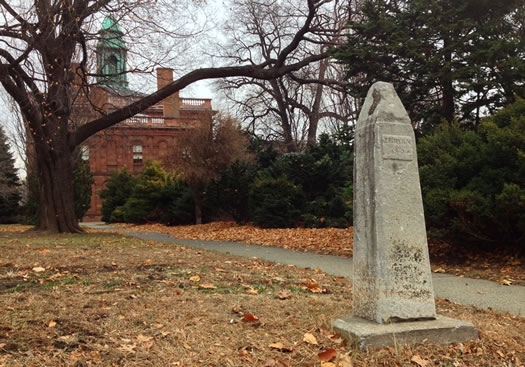
What is that?
A city as old and rich in history as Albany is bound to have its mysteries. Many are easily explained -- others remain unsolved.
If you've been paying close attention, there is one such mystery that stands on the edge of LaFayette Park along Washington Avenue, across from the Capitol. It's the Bryan Stone.
If you aren't familiar with it you aren't alone. Hiding in plain sight, most Albanians don't have any idea it even exists. Tested and worn from surviving almost 200 winters, this marble mystery has held its secret for more than 100 years.
The stone

A close-up of the Bryan Stone engraving
The Bryan Stone juts out of the ground at the southern corner of LaFayette Park. From its wide stone base the marble pillar features four sides stretching roughly four feet high before coming to a rounded point. Although much smaller, the post bears a striking resemblance to the Washington Monument; though it predates the DC landmark by about 25 years.
The stone is engraved, "J. Bryan" with the year, "1824" underneath.
What we know so far
In relation to the long historic timeline of Albany, LaFayette Park is a relative newcomer, having been built in the late 1920s. Before the park, homes and businesses lined this portion of Washington Avenue and the surrounding streets.Â
One of those streets, LaFayette, if still used today, would split the park right down the middle. It began at the northwest side at Hawk Street. Park Place, another long gone thoroughfare, connected LaFayette Street at the southwest corner of the old Albany Academy, then extended to Washington Avenue.
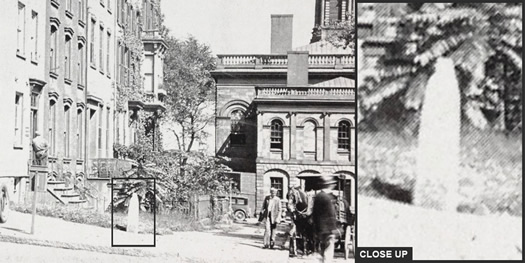
The Bryan Stone circa 1910-1915 / courtesy: The Morris Gerber Collection
In a 1959 Knickerbocker News article, columnist Charles Mooney opined that the Bryan Stone was possibly a grave marker. It was a solid theory. After all, a stone pillar that bears a name and a year could be taken for a tombstone. But three things helped debunk that gravestone theory. For one, records show that no cemetery has ever been established in that area. Next, how could a grave from the early 19th century somehow survive 200 years in the urban center of a city? And finally, if the year "1824" etched into the marble is indeed accurate, then somebody with the last name "Bryan" was buried on Jesse Buel's property. Jesse Buel, founder and editor of the Albany Argus newspaper, owned the property at the time and certainly had enough wealth to bury someone in one of the plotted cemeteries in the city. And if for some strange reason Buel did decide to bury J. Bryan there, then why would he have the poor soul interred so close to the road?
Another theory that's been kicked around for years is that it is a hitching post. At first glance it does resemble one. It certainly has the correct dimensions. In general, a hitching post of this type would have a metal ring embedded into the post to secure the horse's lead rope to. Without it, the horse could end up wandering right into Joseph Henry's class at the Academy, or even worse, disrupting Governor Yates across the street at the New York State Capitol. Although the hitching ring would have long rusted away over two centuries, it would have left behind a hole, some visual pitting or even rust stains as evidence of its duties of the past. The Bryan Stone stands relatively smooth on all sides.
So where does that leave us?
Will the real Morange please stand up?
Back to Mooney's article, he cites an earlier 1937 article that an undertaker named William Morange was interested in finding out once and for all who this mysterious "J. Bryan" was. Unfortunately for J. Bryan, Mr. Morange died before finding an answer. The article only mentions that he died "many years" before the date of the 1937 publication, so his exact date of death is unknown.
Here's where it gets a little interesting. For the majority of the 19th century, there was a William Morange in Albany, but his occupation is listed as a lawyer (and also a poet). There's not a record of an undertaker in Albany by the name of William Morange. The literary lawyer William Morange met a very abrupt and ironic end in November of 1895. While visiting the Albany Argus Building on Broadway, he fell down an elevator shaft and was killed. That Albany Argus? The same Albany Argus that was owned by Jesse Buel? Yes.
So to recap, we have the man who was possibly trying to solve the mystery of who J. Bryan was, mysteriously falling to his death in a building once owned by the man with the Bryan Stone on his land? Very mysterious indeed.
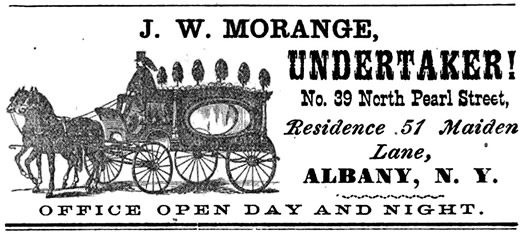
An ad for James W. Morange Undertakers from the 1871 Albany Business Directory
Records show there was another Morange in Albany at this same time. James "W." Morange was in fact an undertaker and funeral director at multiple Albany addresses for most of the second half of the 19th century. He died of old age in July 1911. (Sidenote: Shortly after his death, William Keeler purchased his property on Maiden Lane. Keeler would build his famous hotel on that spot soon after. The Arcade Building now sits on its footprint.)
So which Morange wanted to finally set the Bryan Stone mystery to rest? In the long run it doesn't really matter. Both men went to their graves never knowing the real answer. They only became extra chapters in this mystery novel.
And that leads us to today, over 100 years later and we're still asking, "What is the Bryan Stone?"
The mystery solved
So what is it? It's not a gravestone and most likely not a hitching post. So what else could it be?
Let's take a look at the area in 1824 for some clues. According to maps from the time Park Place wasn't even a glimmer in Albany's eye and neither was Academy Park. In their place was a large public gathering spot named Public Square (or Capitol Square depending on what map you look at.) This area was mainly used for farmers markets and civic meetings. The maps show that Public Square's northwest property boundary ended pretty closely to where the Bryan Stone currently stands.
According to the 1630-1895 Grantor indices at the Albany County Hall of Records a man named John Bryan not only existed in Albany in the 19th century, he was somewhat active in real estate. Bryan, best known as a fur trader and living in the Schuyler Mansion, bought (at least) ten properties in the city between 1803 and 1846.
On June 5, 1826, the indices note that John Bryan and his wife Catherine finalized their purchase of the east half of lots 61 and 62 on the north side of Washington Street from Jesse Buel. Washington Avenue has had its share of names over the years, including Lion Street and Washington Street. Where were lots 61 and 62 situated on Washington Street though? According to the 1812 Albany map that featured exclusively plots of land, lots 61 and 62 were the two most southern plots that sat just west of Public Square. The Bryan Stone sits at what was once the southern-most point to John Bryan's plot of land on the corner of Washington Avenue and Public Square.
The Bryan Stone is a property marker.
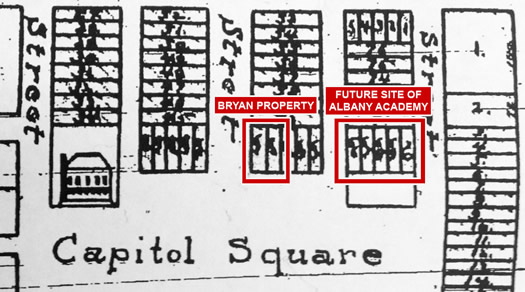
An 1812 Albany map featuring lot numbers / Courtesy: Albany County Hall of Records
The stone may very well be John Bryan's passive aggressive way of saying, "Hey you kids, stay off my lawn!" It does make some sense that a nice sized private property marker would be placed next to a popular public area.
There is one little hiccup however, The Bryan Stone is clearly marked "1824" and the indices report that the land wasn't purchased until two years later. There are two possible explanations for this. In April of 1813, John Bryan purchased the west half of those same lots, so he was no stranger to that corner. He might have had a deal in place 11 years later in 1824 to purchase the east side, going so far to have the marker planted in the ground, before the deal was complete. Turns out he contracted the marble engravers too soon because the 1824 deal fell through. The transaction would finally happen two years later in 1826. A much more probable scenario though would be a clerical error in the indices. It was rather commonplace to have spelling errors or illegible words in the early handwritten history of any city, including Albany. When the indices were transcribed about 70 years later the notary may have simply guessed on the year.
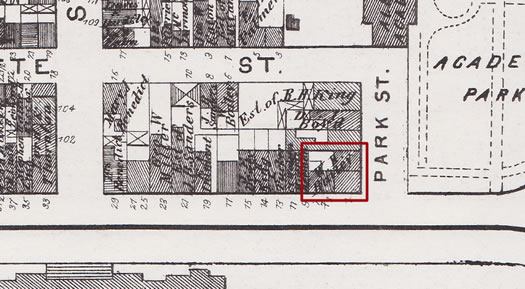
John Bryan's lot circa 1876. Note the east and west sides have been divided.
Looking back, there is a good chance there may have been four Bryan stones in existence in 1824, each standing proudly on the corners of his land. Unfortunately, we'll probably never know if there were three others. Time and development has made sure of that.
The mystery that dates back more than at least 100 years is finally solved. The Bryan Stone can most definitely be explained as being an expensive property marker. Rest easy, Mr. Morange, rest easy.
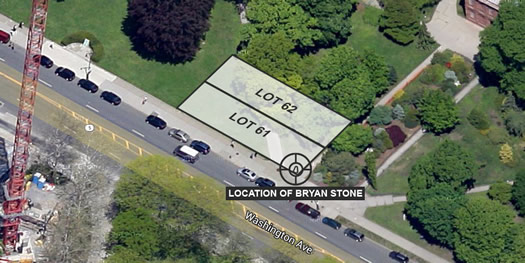
John Bryan's Washington Ave lots overlaid over a current map of the area. / partial image courtesy: Google Maps
Albany Archives regularly shares local historical images and stories via Twitter, along with more detailed stories on its website. It's also the creator of the Albany Postcard Project.
Find It
The Bryan Stone
Lafayette Park
Albany, NY 12207
Hi there. Comments have been closed for this item. Still have something to say? Contact us.
Comments
I absolutely love these local history pieces that are posted every so often. Too few Albanians are aware or appreciate the vast amounts of local history available. On such piece of history that was overlooked, even by myself recently, is the only statue commemorating the 300 mile trek of cannons and artillery from Fort Ticonderoga to Boston (across the Berkshires) during the winter of 1775 located across from Albany Memorial. An idea for your next piece?
... said SuburbanSlumming on Dec 10, 2014 at 11:13 AM | link
Darn it! I wanted it to be a hitching post, you know, like a "reserved parking" sign. Fun story.
... said Joe A on Dec 10, 2014 at 11:23 AM | link
Wonderfully done! I loved this article.
... said daleyplanit on Dec 10, 2014 at 11:47 AM | link
So glad you figured this out, and so bummed it wasn't me. So, are there any other such property line posts around Albany? The only similar markers I've seen are some highway and railroad mile markers still standing here and there.
... said Carl on Dec 10, 2014 at 12:06 PM | link
Great story! I recently started working in the state ed building and have started exploring the downtown area for historical sites and markers. I will definitely check this one out!
... said Amy on Dec 10, 2014 at 12:08 PM | link
You had me at "hiding in plain sight." Great article, Albany Archives.
... said Colleen Ryan on Dec 10, 2014 at 12:18 PM | link
What a wonderful article. I grew up on Elk Street a few blocks up from this park and spent many wonderful summer days playing there with siblings and friends and remember this stone well. I really enjoyed hearing the history of the park area and the stone.
... said D Gentner on Dec 10, 2014 at 2:47 PM | link
super fun article.
... said Jackers on Dec 10, 2014 at 2:56 PM | link
Thanks! This piece has been in the works for the last six months or so. Pretty early on, it was pretty apparent, for me at least, what it was. The problem was I couldn't prove it. A few weeks ago, after a visit to the Hall of Records, and a chance encounter with John Walcott (who was also there doing research), the answer was finally nailed down.
@Carl, this has really been the only property marker I've found still standing. Theres a picture that the APL has of Harmanus Bleecker's home in the 1870s and there was a very similar marker sitting at the corner of Chapel and Steuben. No idea how long that specific marker has been gone though. That picture does prove that there were others at one time though, but we may be looking at the last one though.
... said Albany Archives on Dec 10, 2014 at 2:57 PM | link
to follow up suburban slumming, there is another Knox trail marker at the route 9&20 split in the town of Schodack . I to have often wondered how many Knox trail markers there are between Boston and fort Ti?
... said Hoff on Dec 12, 2014 at 1:24 PM | link
Do you think grave stones and markers were fashioned from the property markers, ?
... said Gloria Lambert on Dec 12, 2014 at 6:33 PM | link
Great article. I just noticed this marker a few weeks ago during a lunchtime stroll and am happy to know its story.
... said Teresa on Dec 13, 2014 at 7:47 AM | link
I recently found out where my grandfathers dads restaurant (Paulus)was around 1908. 5 Market Square in Albany where the Times Union Center is today.
... said Nancy on Feb 25, 2015 at 12:51 PM | link
I'm not thrilled to report that the Bryan Stone was toppled (by accident, I'm sure) during the Freihofer's Run this morning. Here's hoping it can be fixed quickly.
... said Paula on Jun 4, 2016 at 12:58 PM | link
I love this. It's close to my house and even closer to my bus stop, and just like you said, I don't remember ever seeing it. Now I'll have to take another look.
... said Summer Wilber on Jun 7, 2016 at 4:06 PM | link
Summer, I agree it does tend to blend in until you first see it. I'd wait a few weeks, though. It was knocked down during the Freihofers run and won't be repaired and replaced for about two weeks according to Historic Albany's Twitter.
... said JayK on Jun 7, 2016 at 5:33 PM | link
WOW, BORN IN RENNS, NY + LIVED IN ALBANY FR. AGE 1. I NEVER KNEW ALL THIS INFO. THANK YOU SOO MUCH!!! VERY INTERESTING. I MUST HAVE WALKED BY THAT STONE MORE TIMES THEN I CAN COUNT.. IF I STILL LIVED IN ALBANY, I WOULD GO SEE IT AGAIN.. BUT I MOVED TO FL 1 YR AGO. HOPE MY CUZ SEE THIS. SHE IS WRITING A BOOK ON 'THE AIKENS" FR. RENNS,NY. HENCE" THE AIKEN HOUSE" IN RENNS,NY
... said judith aiken-diederich sr on Nov 14, 2016 at 1:49 PM | link
Just stumbled upon this... as a Morange (these are my relatives), this was a great and random find! Thanks!
... said K H MORANGE on Jan 10, 2017 at 3:52 PM | link